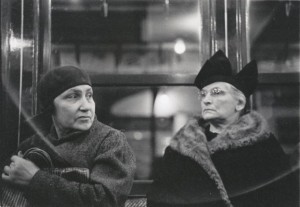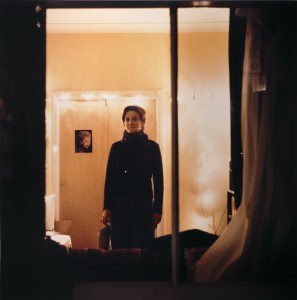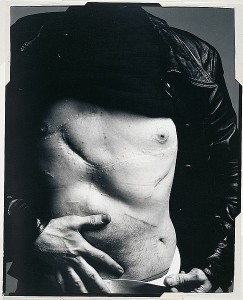Forced Exposure
November 3rd, 2010In “Michael Wolf’s Penetrating Lens” I described an exhibition of images snapped surreptitiously of people in their homes. I considered both the legality and the ethics of the photographer’s voyeurism and concluded that “just because you can do a thing doesn’t mean you should.”
As a photographer myself, the balance between the right to take a photo and an individual’s right to privacy is of keen interest, so yesterday I attended a lecture at SFMOMA by Lisa Sutcliffe, assistant curator of photography, about the museum’s exhibit “EXPOSED: Voyeurism, Surveillance, and the Camera Since 1870.” According to the statement, “this provocative exhibition examines some of the camera’s most unsettling uses, including pornography, surveillance, stalking celebrity, and witnessing violence.”
Sutcliffe cites the development of the dry plate process as critical in bringing photography out of the studio and into the streets. Once freed of that constraint photographers began capturing scenes around them. She mentioned that the term “snapshot” was drawn from hunting terminology: One “shoots” or “takes” (a photo of) their prey. To do this successfully required some ingenuity on the part of the photo hunters.

"Subway Passengers, New York," Walker Evans (1938)
She told of the use of right-angle viewfinders allowing a camera to be pointed in one direction while shooting in another. This kept the subject from realizing they were being photographed and reacting to the intrusion.
As cameras became smaller they were easier to conceal. She described how Walker Evans hid a camera under his coat to photograph passengers in the New York subway in the 1930s. As he could not use the camera’s viewfinder, he “had to trust his gut, and shoot from his chest.” (Sutcliffe will be speaking further on Evan’s subway series on November 11 at SFMOMA.)
Largely because of advances in photography, “our perceptions of respect, vulnerability, and security have shifted over time,” Sutcliffe said.
One of the lecture’s most intriguing anecdotes was the story of Shizuka Yokomizo, who slipped notes under strangers’ doors addressed, “Dear Stranger” and signed “The Artist.” In these notes she informed them that she was working on a photo project and would like to photograph them through the front window of their home. They would remain strangers. If they agreed to participate, they were to stand before the window for ten minutes at the specified date and time. If not, they could indicate their refusal by closing their curtains.

"Stranger #2," Shizuka Yokomizo (1999)
What motivated those who agreed? In “Stranger #1” (1998) a man stands in his boxer shorts, looking quite comfortable, and chatting on a cordless phone. In “Stranger #2” (1999) a woman is bundled up and stands with her arms at her sides, as though at attention. Do they care whether this really is an artistic endeavor? Are they lonely, or seeking titillation?
At times the scope of the exhibit seemed overly broad. Photos of prostitutes engaged in sex acts taken through a “forgotten window” illustrate the themes nicely. However, shots taken of prostitutes leaning out of brothel doors to pose for the photographer do not.
Voyeurism is defined:
In clinical psychology, voyeurism is the sexual interest in or practice of spying on people engaged in intimate behaviors, such as undressing, sexual activity, or other activity usually considered to be of a private nature. In popular imagination the term is used in a more general sense to refer to someone who habitually observes others without their knowledge, with no necessary implication of sexual interest.
Voyeurism (from the French voyeur, “one who looks”) can take several forms, but its principal characteristic is that the voyeur does not normally relate directly with the subject of their interest, who is often unaware of being observed.

"Andy Warhol, artist, New York," Richard Avedon (1969)
Readily recognizable works such as Brassaï’s “Lovers in a small cafe, near the Place d’Italie” (1932), Helmut Newton’s “Woman Examining Man, Saint-Tropez” (1975), and Avedon’s “Andy Warhol, artist, New York” (1969) add star power to a collection comprised largely of unknown or little known photographers. But if these staged images speak to voyeurism or surveillance, then any photo does. Is that the point?
“EXPOSED: Voyeurism, Surveillance, and the Camera Since 1870” runs through April 17, 2011 at SFMOMA. Don’t forget that admission to the museum is free the first Tuesday of every month.
Michael Singman-Aste
Postdiluvian Photo
Tags: Andy Warhol, Brassaï, Helmut Newton, Henri Cartier-Bresson, Michael Wolf, Richard Avedon, San Francisco, SFMOMA, Shizuka Yokomizo, Walker Evans



Leave a Reply
You must be logged in to post a comment.